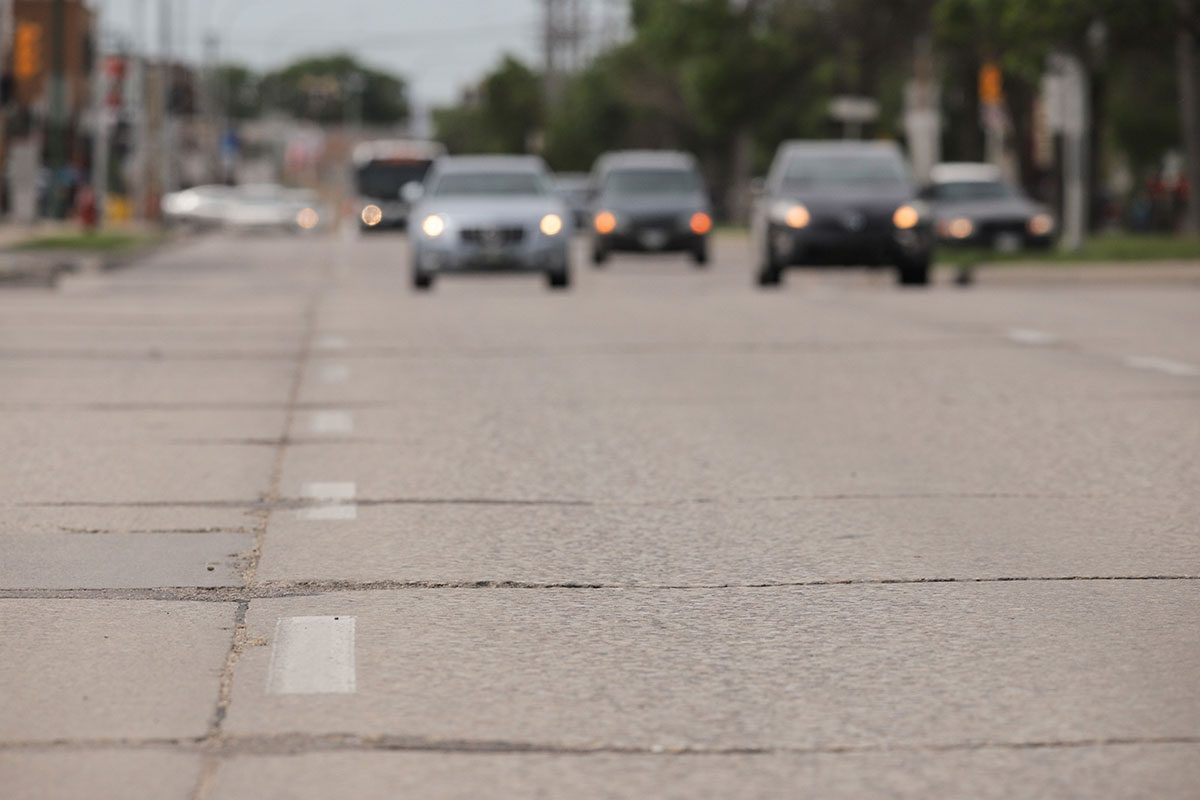
Traffic photo from Leif Norman.
The Conversation: After Humboldt: What is being done to reduce risks on Canadian roads?
The following article appeared on The Conversation on Jan. 8, 2019 from Ahmed Shalaby, professor of civil engineering at the U of M:
The Humboldt Broncos bus crash last April caused 16 fatalities and 13 injuries and has resulted in the driver of a transport truck pleading guilty to 29 charges. The heart-wrenching event was chosen as Canada’s top news story of 2018.
The crash was another blow to Canada’s unflattering record in road safety, and it begs the question: what is Canada doing to advance road safety?
Read more: After the Humboldt crash: Truck driver health and training must be a priority

Ahmed Shalaby. // PHOTO FROM LEIF NORMAN
My research work as a transportation engineering academic focuses on improving the materials and construction practices used to make roads and airfields safer, more durable and more sustainable. Through this work, I have witnessed the impact of the diminishing role of the federal government in road safety.
Investigating causes, determining responsibility
In the aftermath of a major road crash or a bridge collapse, two types of investigations are necessary. One investigation reconstructs the crash to determine how the incident happened and who is responsible. This investigation culminates in the laying of criminal and negligence charges where appropriate and becomes the basis for court action. Law enforcement agencies are typically in charge of this type of investigation.
The second investigation is an independent safety investigation that is not concerned with the assignment of blame. Rather, it focuses on uncovering the facts and finding what could be done differently to prevent a future repeat of the tragedy.
The safety investigation recommends improvements both at the scene of the incident, and broadly in the systems, regulations and technologies that are in place to protect the public. A watchdog is necessary to monitor the timely implementation of the recommendations.
Federal role in regulation and oversight
Transport Canada is the federal regulator of all transportation modes and has an overarching responsibility for the protection of the public from transportation incidents.
But Transport Canada’s budget and staffing levels reflect an utter abandonment of road safety at the federal level. As their own figures show, road and motor vehicle safety — the source of 95 percent of all transportation fatalities — constitutes only three percent of the budget of transportation safety programs, a mere $25 million per year.
Investigation and oversight of the vast transportation networks are the responsibility of the Transportation Safety Board (TSB). However, road transportation has not been included within the TSB’s mandate since its establishment in 1990. The operation and maintenance of the road network is a provincial and territorial responsibility, not the business of the government of Canada.
The criminal investigation
In the Humboldt crash, the criminal investigation was handled by the RCMP. Although the RCMP is a federal agency, it also operates under contract as a provincial law enforcement body outside of Ontario and Québec and in cities and towns that don’t have their own local police forces.
The RCMP’s Traffic Services Unit has the expertise to reconstruct crashes to assign fault. Due to the magnitude and complexity of the Humboldt bus crash, the Major Crimes unit headed this investigation.
The RCMP’s first public response came 13 days after the crash. It was a cryptic message that confirmed that the tractor-trailer truck “was in the intersection at the time of the collision.” Their next update was the laying of charges against the truck driver, Jaskirat Singh Sidhu, three months after the crash.
On. Jan. 8, Sidhu pleaded guilty to 16 counts of dangerous driving causing death and 13 charges of dangerous driving causing bodily harm. It’s been reported that a statement of facts about the crash based on the RCMP’s investigation indicated that Sidhu did not heed the stop sign and drove into the intersection at a speed of 86-96 km/h, where his truck was “T-boned” by the hockey team’s bus.
Provincial investigation of the crash intersection
While there hasn’t been any announcement of a comprehensive safety investigation, the Saskatchewan Department of Justice requested a review of the safety of the crash intersection. That assignment went through the regular procurement channels and was awarded to a consulting engineering firm three months after the crash.
The scope of the study was limited to the review of the geometric layout, collision, traffic and human factor characteristics of the crash intersection to identify factors that could increase the risk of collisions at the intersection and recommend improvements.
The scope left out investigating the Humboldt bus crash itself, and didn’t require access to the vehicles involved in the crash or their data.
The study report was released in December 2018. It showed that the consulting team visited the intersection on Aug. 30 and 31, 2018, nearly five whole months after the crash, and in very different climate and traffic conditions. Moreover, the team was unable to obtain information from the two RCMP units that conducted the criminal investigation and examined the crash scene for several weeks after the crash.
The report recommended improvements, but decided against changing the operation of the intersection from a two-way stop sign. It recommended the removal of trees from an acre of private land near the intersection because they interfered with sight lines. However, it allowed the province between two and 10 years to negotiate the removal with the landowner and to proceed only if the cost is reasonable.
Accountability in the wake of disaster
To contrast the limited scope of the intersection study ordered by the province, consider the 2013 Lac-Mégantic rail disaster which claimed 47 lives. Consider if the TSB investigators — who had unfettered access and were on site the morning after the crash — were limited to the rail track and didn’t have access to the locomotives or tank cars. What if the TSB team haven’t visited Lac Megantic until five months after the crash?
It wouldn’t be acceptable, of course, given the magnitude of the disaster.
What the Humboldt crash reveals is that Canada’s response to major road incidents is woefully inadequate and its capacity to learn from failures is, at best, questionable.
In the absence of an independent safety investigation, families of crash victims and others (including myself) have publicly called for establishing minimum federal standards for training commercial drivers and for updating seat belt regulations for coach buses and school buses.
In essence, Canadians are being exposed to unnecessary risk because Transport Canada is severely under-funded and under-resourced. Moreover, the TSB is gagged, despite already having unparalleled technical expertise.
At the same time, a technological transformation is taking place on the roads with connected and self-driving vehicles, route guidance and ride-sharing and the use of dashcams and vehicle data recorders. The transformation also extends to the ways roads and bridges are designed, built, inspected and repaired.
There is progress toward making the roads safer, but much more is needed to change the status quo, starting at the federal level. To reduce the risk to road users, Parliament can strengthen Transport Canada’s capacity to regulate motor vehicle and road safety programs, and empower the TSB to investigate major road crashes and issue safety recommendations.
Research at the University of Manitoba is partially supported by funding from the Government of Canada Research Support Fund.








Very-well stated Dr. Shalaby.
I completely agree with your statements and add that early-on, the statement of facts put the responsibility of the crash “fully on Sidhu saying Doerksen recognized the hazard early and tried to avoid the crash.” Many things are wrong with that statement, but the biggest concern is that ONLY the drivers of either of the vehicles are claimed to be responsible when it is widely known and accepted there are many contributing factors including (to name a few); hardware elements such as the two semi-trailers, the load of peat moss, the bus (crashworthiness, etc.), load securement, wayfinding, seatbelts; as well as environmental factors such as the trees, the road design, time of day, the intersection; management or software aspects such daily drivers’ logs, safety plan, hiring, orientation, training, work schedules, design standards and driver-related factors such as experience, training and sight-lines. With the Sask Min of Highways and Infrastructure report overlooking nearly all of these systemic factors; partly due to the expertise of the investigation team, the scope of the investigation and importantly, the timing of the investigation which as was stated was approximately 5 months too late!
The truck driver did not see or respond to the stop sign yet he was not impaired or distracted. An analysis of that event would help identify the host of dynamic, systemic factors that played a role and can ultimately be addressed to bolster passenger, vehicle and road safety.
All human actions and decisions are embedded in a context. To “blame” the central actor(s) in any event is woefully inadequate and leaves the “system” untouched with the very high propensity for the same event to re-occur. Famously quoted by James Reason, “we can’t change the human condition, but we can change the conditions in which the human is embedded.” Giving the mandate and resources to the TSB to conduct a systematic investigation of road crashes involving 10+ victims is crucial.
Error is not so human; actions and decisions emerge from a context with many constraints. Identifying and understanding the full context and constraints is needed. A second point is that learning is also needed. All that has been learned should be shared, made transparent and used to improve safety across the road system in Canada. Driver training and removing trees (which could take 10 years) do very little to change the system in a meaningful way to prevent recurrence. This is a huge problem. To really be effective, the TSB must be given teh mandate to undertake road safety investigations to understand all the contributing factors and in-turn be able to identify effective preventative measures.